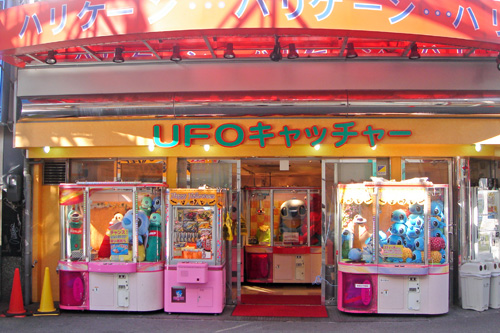
The Japanese machine arcades are loaded with awesome graphics. I’ve played a little pachinko, but it’s not as much fun as it was ten years ago, the games are less like pinball and more like slot machines now. Great walls of noise in the pachinko parlors. Wikipedia says a lot of them are owned by sinister North Koreans and yakuza.
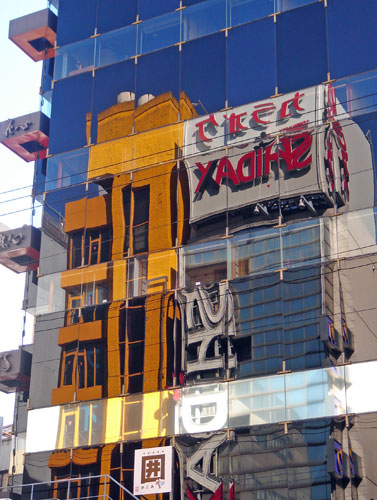
We saw a famous sight called the Golden Temple, but this golden skyscraper in a mirrorwall is more photogenic. Like, so what if something’s gold? Hushed awe before rare minerals.
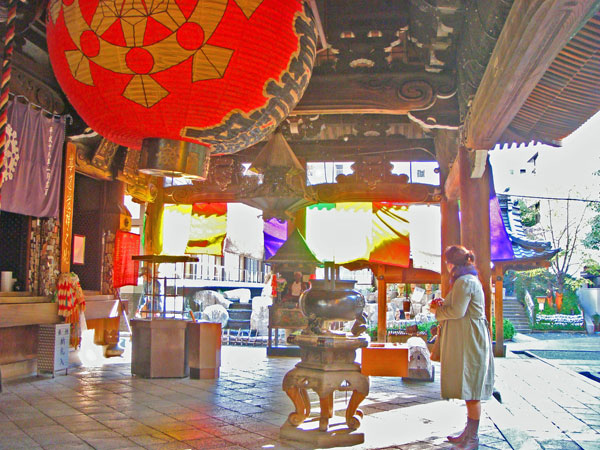
No need to go to the crowded temples and shrines, I’m finding, as there’s one every few blocks anyway. I like the giant lantern in this one. Spent a peaceful half hour there this morning before the strenuous business of attending lectures and seeing “real” sights.
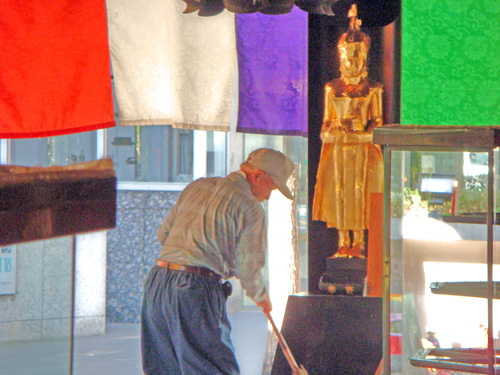
An old guy was sweeping out the temple grounds with a twig broom. People wandering by, throwing a coin in the big grate, clapping their hands to pray, pulling on a fat rope to ring a gong so the gods hear. That statue of the god is covered with squares of gold paper that people have stuck onto it, so the face, in particular, is swathed.
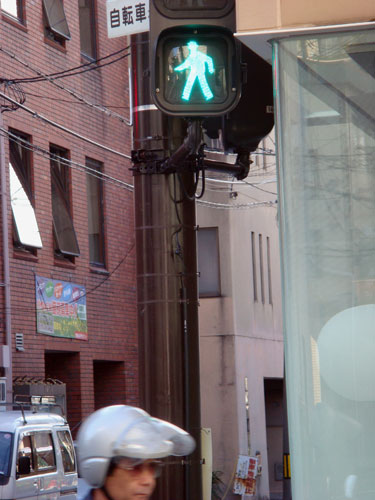
Even the little figures in the Walk/Don’t Walk signs look Japanese, I noticed today. They’re wearing hats.
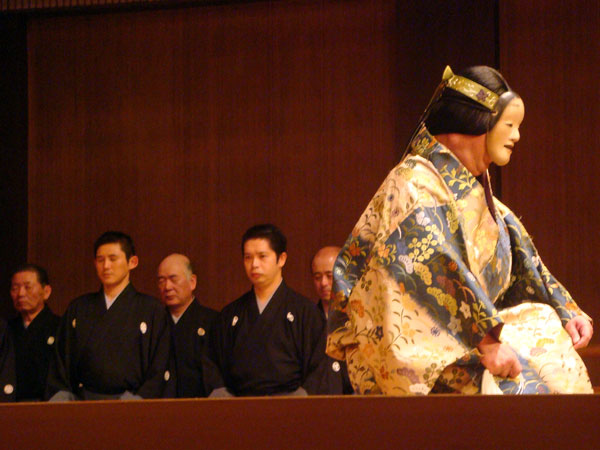
We bought tickets to the Noh theater this afternoon. It was three short plays. Well, not really plays in the Western sense. Noh is more about getting some feeling going and milking that. The second one was about a mother looking for her lost child. The mother was played by a stout man wearing a “mother” Noh mask. I’d seen Noh masks before and had remarked upon how small they are; I’d thought maybe the ones I’d seen were just models. But they really do wear a tiny mask like that on the stage. It barely covers the actor’s forehead and mouth. The mask was carved in an interesting way, so that, depending on the tone of the performer’s voice, the mask looked either happy or sad, even though really it’s immobile wood. They had three musicians onstage as well, two drummers and a guy with a flute, and a chorus of men. The flutist went only for gnarly sounds, blowing the flute so hard that the notes split, fuzzed and cracked. The drummers kind of yodeled.
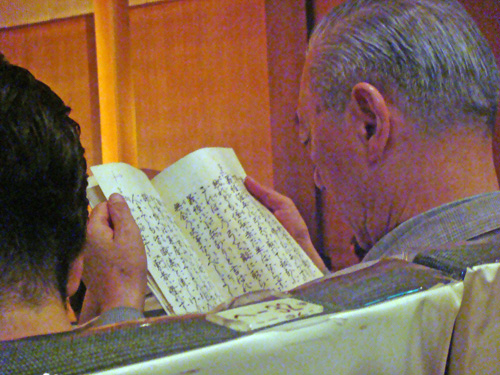
The first of the three Noh plays was pretty dull. It was seven guys dressed in gray and black, kneeling on the stage, intoning in mournful tones a poem about a dead warrior’s ghost in Japanese for 45 minutes with no music. Most of the people in the audience were digging it, though. They were following along in books. Almost all of them were older than us.
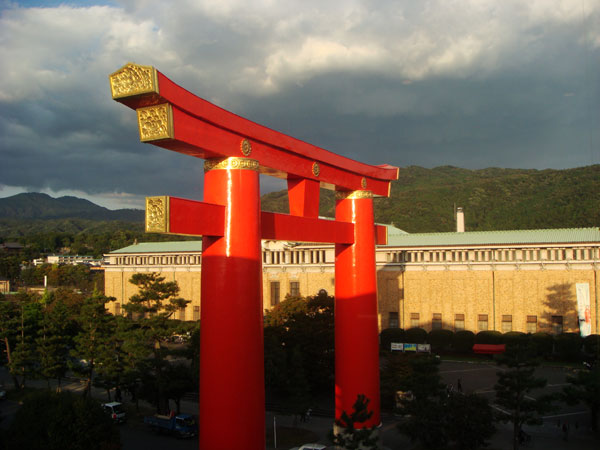
Back outside it was a sunny October day. This enormous orange arch is outside the Kyoto Museum of Modern Art, we peeked in there. I kind of like the way the Japanese were painting in the 1930s, it’s still the old themes, but with more color.
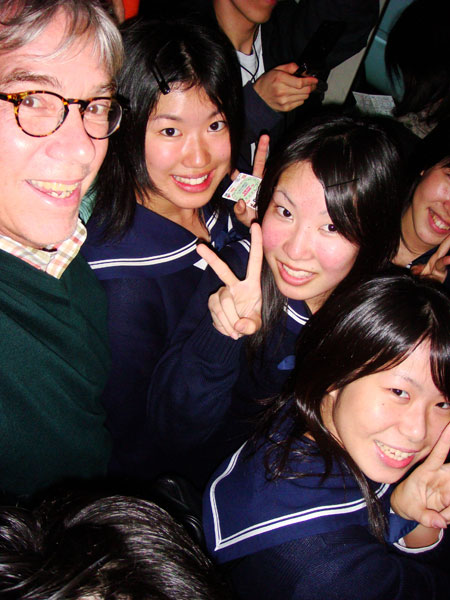
It was Saturday and the buses were jammed. On the ride home I was squeezed in with a gaggle of cute school girls; they loved it when I took this picture. They took pictures of me back, and practiced their English on me. They were in Kyoto on a class trip from Hokkaido, the somewhat rural northern island of Japan. Just about every single time a school girl poses for a photo here, she flashes the old “peace” sign. Incredible that’s still in fashion after, what, forty years. I wonder if it, like, went out and then came back in? Or if it’s just a permanent thing now. I made sure to flash the V myself when it was my turn to pose.









October 20th, 2007 at 6:58 am
Rudy,
the last photograph just cries out for some sort of caption competition…
October 20th, 2007 at 8:09 am
“Isaac Asimov’s 2007 Sensual Dirty Old Man Competition Winner!”
October 20th, 2007 at 9:45 am
V — I’m guessing they have no idea what the V stands for, they just “know” those strange Americans do it. And you proved it.
October 24th, 2007 at 9:43 pm
Tibetan kids all flash the peace sign too. They do it so much that you start doing it back, then you do it pre-emptively. It’s better than what the government schools teach them they’re supposed to do: Salute.
November 2nd, 2007 at 5:19 pm
I’ve seen Japanese kids do the peace sign thing for at least 17 years. Back in around 1990 I was a huge fan of Japanese pop culture and had a huge collection of Japanese magazines and most of the girls in the magazines were doing the peace sign thing.